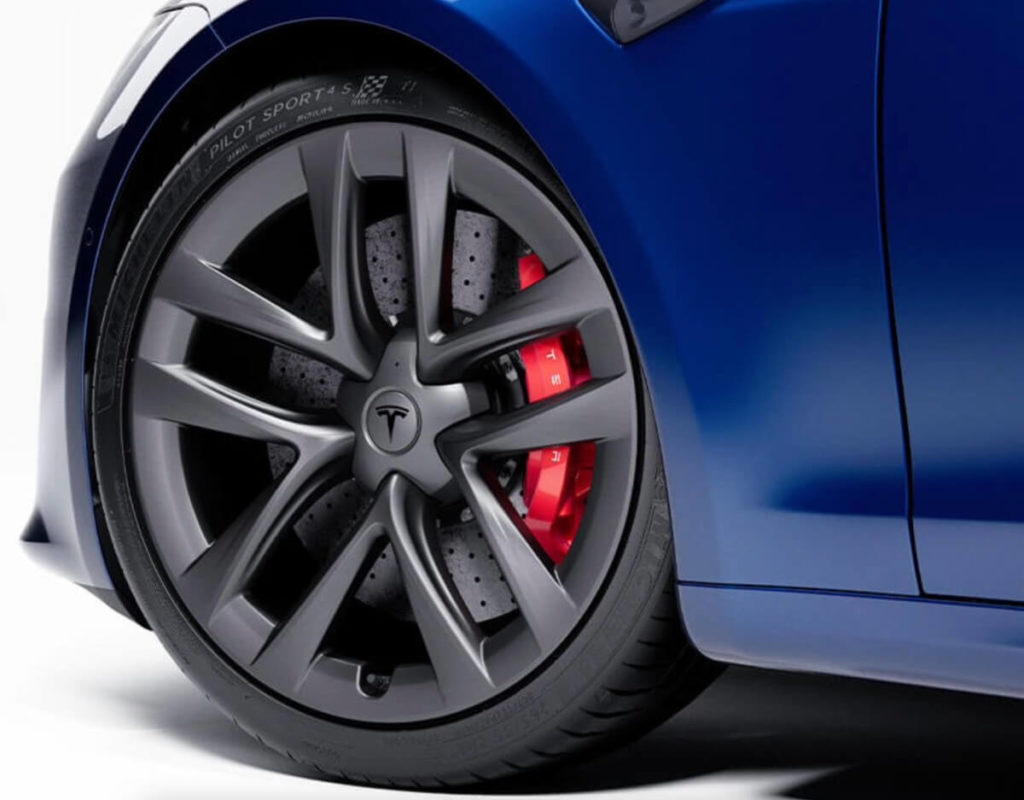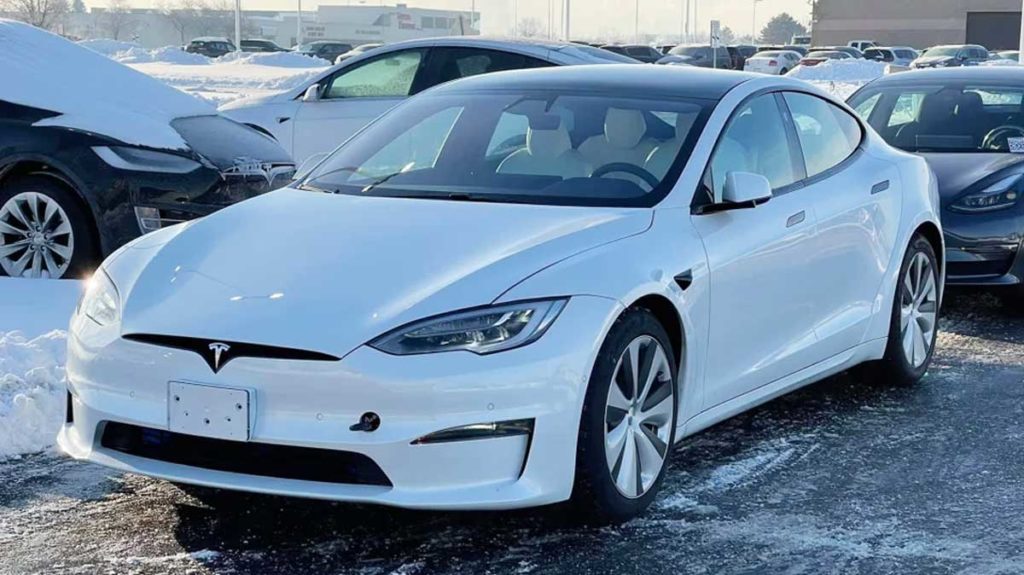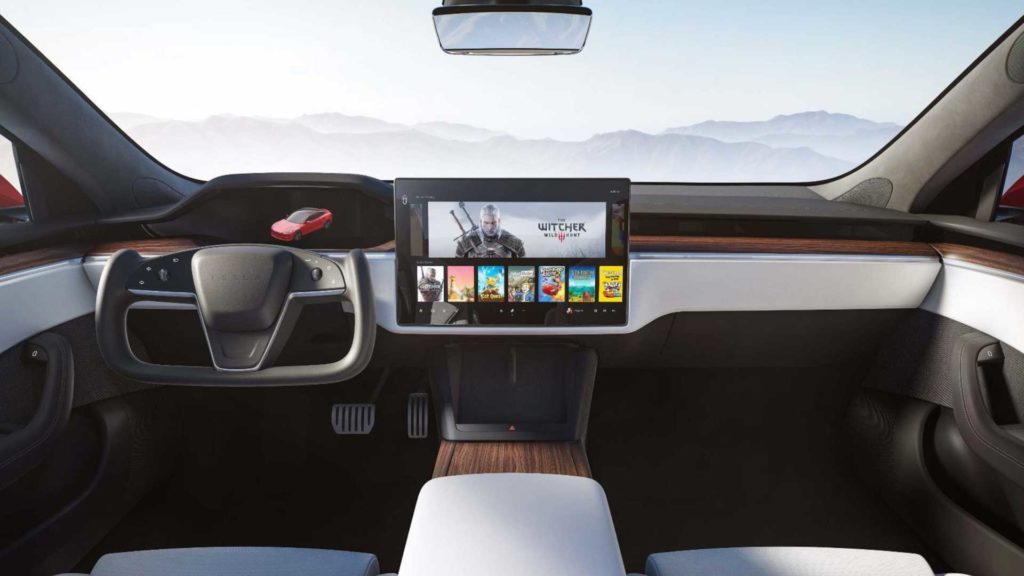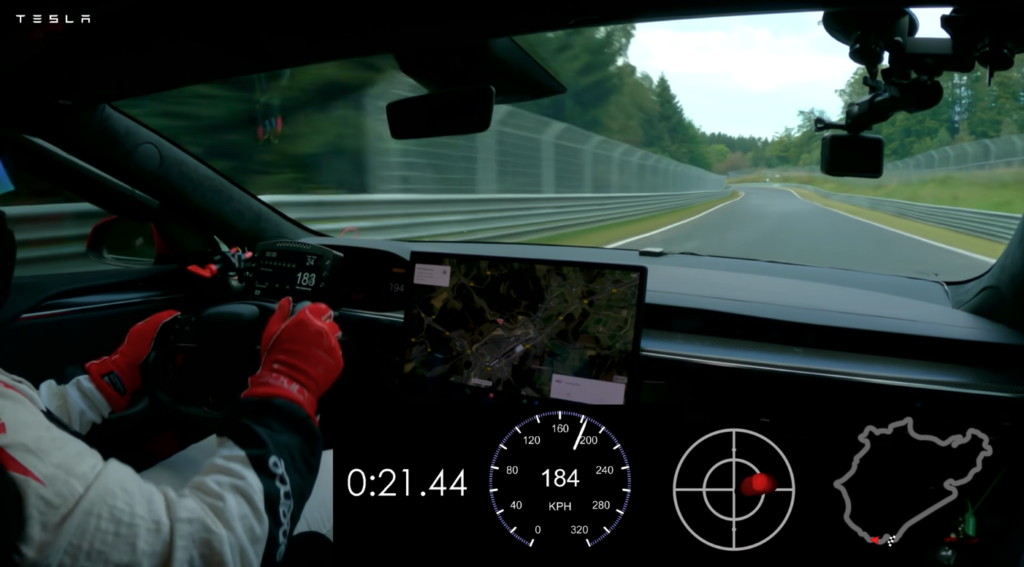Elon Musk has said that the Tesla Model S Plaid features some of the most advanced secret technology on earth. What are these “practically alien” innovations he’s referring to? Come along for a drive with me and let’s explore the most interesting technical highlights of the vehicle.
Table of Contents
ToggleTesla Model S Plaid
Frankenstein Creation
The 2022 Tesla Model S Plaid is a Frankenstein creation of the 0-60 EV arms race, half grocery sedan, half-million-dollar hypercar. A polite whizzing and beeping robot on wheels whose acceleration outpaces human reaction time and humbles every other car on the road.
When you step into the cockpit, you’re entering a new automotive paradigm that redefines your perception of time and space. An alternate universe where 120MPH is 60, and the controls are a low latency human-machine interface tied directly into your nervous system.
Car as a Spaceship
Elon described the car as a Spaceship, and while the driving experience is out of this world, a yoke is normally found on an aircraft. The Tesla Model S Plaid is the quickest production car on earth. The Plaid features a few key upgrades that push the limits of physics and make it different than any Tesla before it.
Let’s first bring the car behind enemy lines at the drag track and explore her most publicized feature.
Features of Tesla Model S Plaid
The special drag strip mode
The Model S Plaid has a special drag strip mode to produce maximum acceleration for racing and demonstration. Select drag mode and the Plaid Tesla begins a high-performance thermoregulation regime, running glycol through the heat exchanger to cool a synthetic oil which is pumped to the vehicle 3 drive units, one up front, and two in the rear. Push down on the brake and accelerator simultaneously, and the car’s front end crouches into a Cheetah stance in preparation for launch. Foot off the brake, and the vehicle launches.
Notice the front end lift slightly skywards as the weight is gravimetrically transferred to the rear tires during peak acceleration. The acceleration is a physical experience. The G-force pushes your spine into your seat horizontally with a force over 1.2 times your bodyweight. This low vibration, linear acceleration feels like a pulling sensation, as if an invisible steel cable was steadily pulling you down the track, as opposed to a combustion-engined car, which feels more like being pushed along by a rumbling rocket.
Rear motor assembly
What makes Plaid’s powertrain different than any other electric car on the road? The rear motor assembly is Plaid’s most significant upgrade. It consists of two souped-up Model 3 drive units placed back to back, housed symmetrically inside a precision aluminum subframe. These rear motors are coupled directly to each wheel with a single-speed transmission.

In electric vehicles, you only need one gear because the motors operate at higher RPMs than internal combustion engines, and produce stronger torque at low RPMs. Essentially, the Plaid needs to reduce the speed of rotation from the high-speed electric motor, to deliver optimal wheel torque.
7.5 to 1 gear ratio and incredible engineering
Tesla opted for a 7.5 to 1 gear ratio, which means for every 7 and a half turns of the rotor, (the spinning component inside the motor) the tire will complete one full rotation. So to achieve Tesla’s stated top speed of 200 MPH, the motor would need to redline at approximately 24,000 RPM.
To achieve such high performance, Tesla had to think outside the box and incorporate some exotic materials and novel engineering methods. It’s hard to imagine how powerful these little motors are. At max RPM’s this whining, hot mass of neodymium magnets is so energetically dense. it’s like a little pulsar star. Just like the battery and range equation, the limitations and constraints of EV motor performance come down to material science and engineering.
It’s just hard to make a motor this size spin that fast without it blowing apart or overheating. All 3 permanent magnet synchronous reluctance motors contain an innovative carbon fiber sleeved rotor instead of a traditional metal sleeved rotor. This carbon fiber sleeve constrains the copper rotor from expanding due to radial acceleration, permitting higher RPMs and creating a stronger electromagnetic field.

This gives the car a very linear powerband with peak horsepower at 80MPH up to 200 MPH. Although, the current top speed is electronically limited to 163 MPH to keep things reasonable. But the incredible thing about modern EVs is that they’re fundamentally controlled by software, and massive performance gains can be unlocked with over-the-air updates.
Carbon ceramic brake kit
But why is Elon holding back? Is he scared to give Tesla customers more cars than they can handle? It appears a software update can unlock double-century speed. But you might need some hardware upgrades if you want to be able to stop.
A curious listing for a Plaid Carbon Ceramic Brake kit popped up on Tesla’s website.
And It seems Tesla is waiting to ship this improved stopping power before they unlock 200MPH to regular customers.


Elon frequently argues that building a factory is about 100 times harder than building a car, and it’s the machine that builds the machine that represents the greatest engineering challenge. For the carbon sleeved rotor, this proved true yet again.
On Twitter Elon Said, The Plaid carbon-wrapped motor is arguably the most advanced motor on Earth outside of maybe a lab somewhere. We have to keep some secrets!
Elon is referring to the manufacturing process. Tesla found a way to tightly wrap the rotor in carbon fiber without the use of heat, which could weaken the magnets. They accomplished this by “Winding the fiber over the rotor at a high tension load with a custom machine designed by Tesla automation”
It’s incredible how all this engineering work happens on the backend, but let’s talk about the differences you can see.
Design
In terms of design, notice the wider fender flares to accommodate wider wheels, different rear paneling, a reworked hood, plus a carbon fiber spoiler. The bulging bodywork signals the vehicles more powerful internals, but in electric vehicles, there’s no need for a long sweeping hood, massive air intake, or a big shiny grill. Cargo cult relics of 125 years of luxury heat engine design tradition.
The Tesla Plaid maintains an understated appearance with subtle hints that it contains something extraordinary. But somehow still manages the lowest drag coefficient of any production car ever built.

Fully autonomous driving
Speed
The record ¼ mile speed for the Plaid is 9.081 seconds at 154.10 mph, and the car produces 1,020 horsepower and 1,050 lb-ft of torque. But there’s a lot more to a car than just driving fast in a straight line.
Steering profile
Normally a yoke is found on aircraft, where a pilot can pull up to control altitude, pitch, and roll. On the Tesla, it’s just a steering wheel with the top half cut off. It can be a bit, disorienting at low speeds until you get used to it, and it takes a bit of, practice.
Tesla is setting the table for fully autonomous driving with a smaller, more compact steering profile that reduces central gauge cluster obstruction. It’s a spooky sight to see that yoke moving all on its own while cornering sharp turns. But how does it work mechanically?
The Model S Plaid uses a rack and pinion steering system. When you turn the yoke, you’re engaging a gear that translates the rotational motion into linear motion, moving the direction of the wheels from side to side with a little electric assist. All pretty standard so far.
But here’s where things get autonomous?
There’s a simple brushless DC motor and control board mounted right on the steering rack inside the front subframe. When the autopilot is engaged, this motor drives a belt connected directly to the input shaft. It turns the yoke just like a human driver would. This elegant belt-driven steering rack is robust enough to handle the maneuvering demands of any real-life scenario, as soon as the software can catch up to this crazy simulation we call reality. On the road, the car feels balanced and sporty, but you can sense the power-assisted steering compensating for the extra weight of the battery.

Improved handling
The Plaid’s ride height is a bit lower than previous models, which improves handling, and it’s bolstered by Tesla’s new air suspension with adaptive damping. A computer is pinging sensors on the car’s suspension 1,000 times per second making rapid adjustments to minimize body roll and isolate road imperfections.
On the rear wheels, all torque vectoring is done electronically. It is done by controlling the frequency of power supplied to the motors with Silicon Carbide MOSFETs in the Inverter Stability control systems measure your steering & pedal inputs against each wheel’s available grip, adjusting torque to give you the best traction. By using precise torque vectoring on the two rear electric motors located on the same axle, launch and handling characteristics are improved.
Testing
The Nurburgring race track in Germany has emerged as the ultimate proving ground to test the performance of electric vehicles. It provides perfect real-world conditions to test attributes such as speed, acceleration, braking, and handling.

In September of 2021, an unmodified Tesla Model S Plaid set a new lap record for electric production cars at the Nurburgring, with an official lap time of 7 minutes and 35 seconds, with an average speed of 103 MPH / 166 km/h. These performance figures are impressive, and it makes sense that electric cars are beating combustion-engined vehicles.
EV challenges
Fundamentally electric propulsion operates at far greater thermal efficiency than combustion engines, which lose lots of energy as excess heat. But EV’s do come with their unique challenges.
When thinking about electric cars, the heating and cooling system might not be the first thing to come to mind. But this seemingly insignificant detail has a big effect on the vehicle’s range because electric cars can lose up to 40% of their range in cold weather if you turn the heat on full blast.
But how does this Plaid overcome this?
The HVAC system on Tesla Model S Plaid
The new HVAC system on this model uses a heat pump. This provides a 30% longer range and requires 50% less energy in cold weather than the previous generation Model S.
Battery
There’s one thing on the 2022 Tesla Model S Plaid that hasn’t changed since the original Tesla Roadster was released in 2008. The battery pack still consists of standard cylindrical 18650 cells, not yet the larger 4680 cells revealed during Tesla’s battery day in May of 2021.
In the Plaid S, they have scaled down the battery capacity from 104-kilowatt hour to a slightly smaller 100-kilowatt hour pack with improved cooling and electrical architecture. The goal is to ensure the battery can meet the high-performance requirements of the Plaid without overheating or losing power.
The pack contains 7,920 cells, arranged into 5 modules separated by a cooling manifold that channels glycol in a zigzag pattern across the entire pack. This allows impressive charge times. The car can add up to 187 miles of range in just 15 minutes at a supercharger. Eventually, instead of using modules, Tesla plans to structurally integrate the battery cells directly into the platform of the vehicle. This design will reduce the total mass of the battery pack and improve efficiency.
You can make improvements to the thermal regulation and architecture of a battery pack for greater efficiency and faster-charging speeds. But the car’s modest 396-mile range is limited fundamentally by the chemical power to weight ratio of the lithium-ion battery cells.
This might be the last Plaid Tesla we see with the old cells before Tesla makes the switch to those big soda cans currently slotted for the Model Y, Semi, and cyber truck.
On a Tesla earnings call, Elon outlined his plan to consolidate Tesla’s batteries down to 2 or 3 form factors, one with a nickel-based cathode for high-powered vehicles, and the other iron-based for mass-market cars like the Tesla Model 3.
Interior
The Plaid’s interior is reworked from previous models. And not to disappoint, but the interior does not contain any Plaid fabric. The seats are made of vegan leather.
The term “Plaid” comes from the science fiction movie Spaceballs, when their spaceship travels beyond “Ludicrous” speed, the stars warp and create a Plaid pattern. The nomenclature is starting to make more sense now, right?
Strong noise vibration and harshness dampening
The car has very strong noise vibration and harshness dampening, which counterintuitively is very important for electric cars because they don’t have a rumbling motor to mask squeaks and creaks. The cabin is like being inside a pair of noise-canceling headphones. The car features active noise-canceling microphones, that detect ambient sounds, and the car’s speakers generate opposite sound waves that collide and eliminate the unwanted noise.
Touchscreen
The center console gets a new landscape-oriented 17” touchscreen and from there you control all aspects of the operation. Powered by an AMD-Ryzen processor, it’s responsive and packed with Tesla’s signature entertainment features. New for 22 is Tesla’s predictive touchscreen gear selector. Tesla believes all input is an error, and the car is meant to predict what direction you want to go based on the environment.
Cell phone chargers
Lastly, the two inductive cell phone chargers are a nice touch, as wires are the last impediment to civilized computing. If you’re accustomed to the sound of a rumbling motor and the noxious aroma of burning hydrocarbons in your nostrils, it’s tough to accept that the Tesla Model S Plaid is the quickest production car in the world.
But the car was made to prove a point, to demonstrate electric cars can be the fastest and safest cars on the road. As Elon Put it, the Plaid is safer than a Volvo and faster than a Porsche.
The bottom line
Tesla isn’t stopping with just the sedan. They’re even going beyond ludicrous in the SUV form factor too, with a Plaid Tesla Model. The Tesla Model S Plaid is a car for practical folks that appreciate performance over showiness.
Note: Must read All you need to know about KIA EV9 2024 and KIA EV6

